Plan and Review of Administrative Systems for <Company Name> Report
VerifiedAdded on 2023/01/20
|28
|5512
|20
Report
AI Summary
This report details the planning and review of administrative systems for a financial services firm. It addresses the need for an ERP system upgrade due to outdated technology, security concerns, and business expansion. The proposed solution involves implementing NetSuite ERP, migrating to a cloud-based NoSQL database, and integrating with technologies like AI and IoT. The report outlines system goals, user requirements, performance standards, and adherence to internal and external standards. It also covers assumptions, constraints, new policies, resources, implementation strategies, staff participation, training, and ongoing system monitoring for efficiency, effectiveness, and continuous improvement. The report includes appendices with templates for policies, implementation plans, risk management, communication, meeting minutes, and a staff skills matrix.

<company name>
PLAN AND REVIEW ADMINISTRATIVE SYSTEMS
<student name>
<student number>
Edited January 2017 Silvio Greco
PLAN AND REVIEW ADMINISTRATIVE SYSTEMS
<student name>
<student number>
Edited January 2017 Silvio Greco
Paraphrase This Document
Need a fresh take? Get an instant paraphrase of this document with our AI Paraphraser
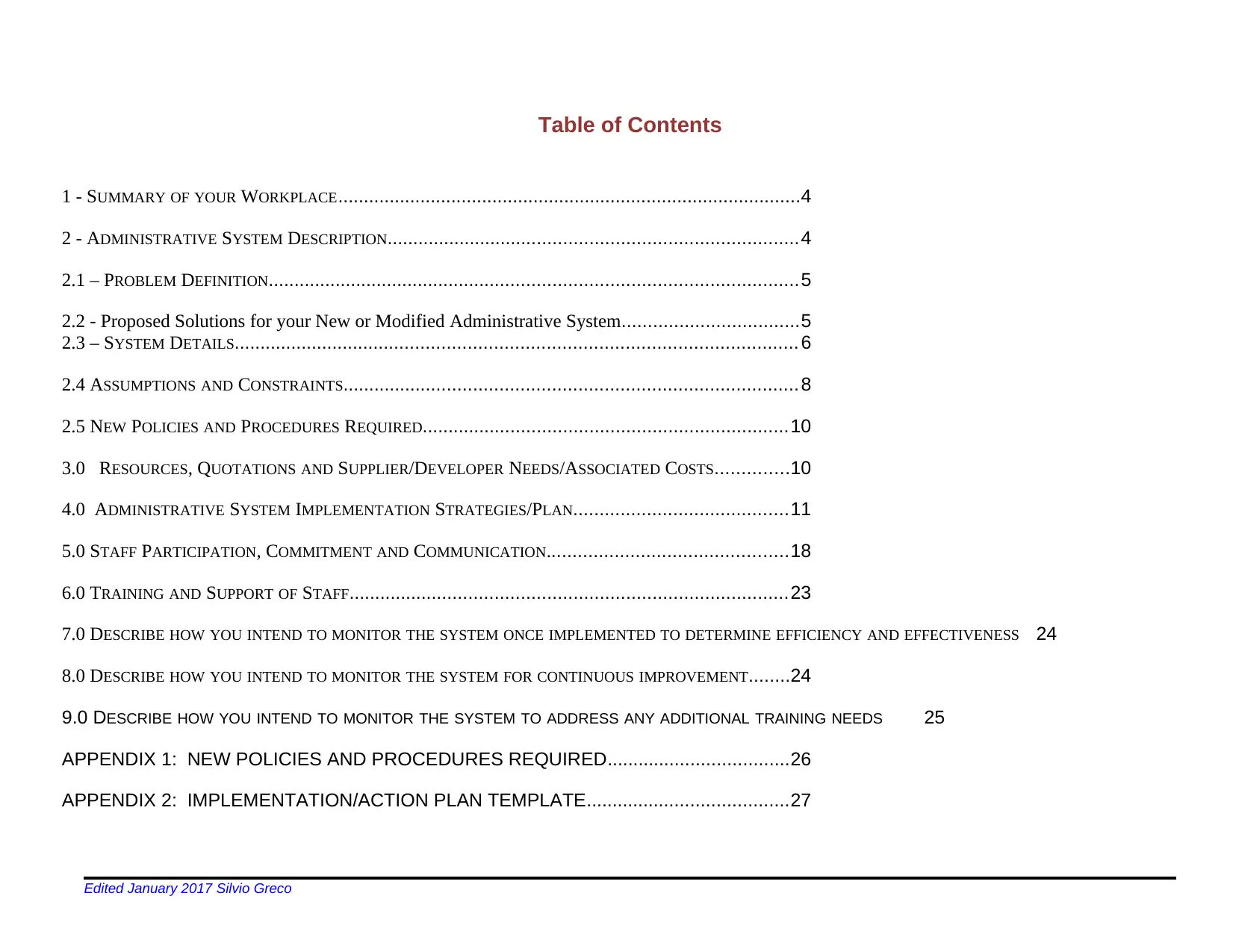
Table of Contents
1 - SUMMARY OF YOUR WORKPLACE..........................................................................................4
2 - ADMINISTRATIVE SYSTEM DESCRIPTION...............................................................................4
2.1 – PROBLEM DEFINITION......................................................................................................5
2.2 - Proposed Solutions for your New or Modified Administrative System..................................5
2.3 – SYSTEM DETAILS............................................................................................................ 6
2.4 ASSUMPTIONS AND CONSTRAINTS.......................................................................................8
2.5 NEW POLICIES AND PROCEDURES REQUIRED......................................................................10
3.0 RESOURCES, QUOTATIONS AND SUPPLIER/DEVELOPER NEEDS/ASSOCIATED COSTS..............10
4.0 ADMINISTRATIVE SYSTEM IMPLEMENTATION STRATEGIES/PLAN.........................................11
5.0 STAFF PARTICIPATION, COMMITMENT AND COMMUNICATION..............................................18
6.0 TRAINING AND SUPPORT OF STAFF....................................................................................23
7.0 DESCRIBE HOW YOU INTEND TO MONITOR THE SYSTEM ONCE IMPLEMENTED TO DETERMINE EFFICIENCY AND EFFECTIVENESS 24
8.0 DESCRIBE HOW YOU INTEND TO MONITOR THE SYSTEM FOR CONTINUOUS IMPROVEMENT........24
9.0 DESCRIBE HOW YOU INTEND TO MONITOR THE SYSTEM TO ADDRESS ANY ADDITIONAL TRAINING NEEDS 25
APPENDIX 1: NEW POLICIES AND PROCEDURES REQUIRED...................................26
APPENDIX 2: IMPLEMENTATION/ACTION PLAN TEMPLATE.......................................27
Edited January 2017 Silvio Greco
1 - SUMMARY OF YOUR WORKPLACE..........................................................................................4
2 - ADMINISTRATIVE SYSTEM DESCRIPTION...............................................................................4
2.1 – PROBLEM DEFINITION......................................................................................................5
2.2 - Proposed Solutions for your New or Modified Administrative System..................................5
2.3 – SYSTEM DETAILS............................................................................................................ 6
2.4 ASSUMPTIONS AND CONSTRAINTS.......................................................................................8
2.5 NEW POLICIES AND PROCEDURES REQUIRED......................................................................10
3.0 RESOURCES, QUOTATIONS AND SUPPLIER/DEVELOPER NEEDS/ASSOCIATED COSTS..............10
4.0 ADMINISTRATIVE SYSTEM IMPLEMENTATION STRATEGIES/PLAN.........................................11
5.0 STAFF PARTICIPATION, COMMITMENT AND COMMUNICATION..............................................18
6.0 TRAINING AND SUPPORT OF STAFF....................................................................................23
7.0 DESCRIBE HOW YOU INTEND TO MONITOR THE SYSTEM ONCE IMPLEMENTED TO DETERMINE EFFICIENCY AND EFFECTIVENESS 24
8.0 DESCRIBE HOW YOU INTEND TO MONITOR THE SYSTEM FOR CONTINUOUS IMPROVEMENT........24
9.0 DESCRIBE HOW YOU INTEND TO MONITOR THE SYSTEM TO ADDRESS ANY ADDITIONAL TRAINING NEEDS 25
APPENDIX 1: NEW POLICIES AND PROCEDURES REQUIRED...................................26
APPENDIX 2: IMPLEMENTATION/ACTION PLAN TEMPLATE.......................................27
Edited January 2017 Silvio Greco
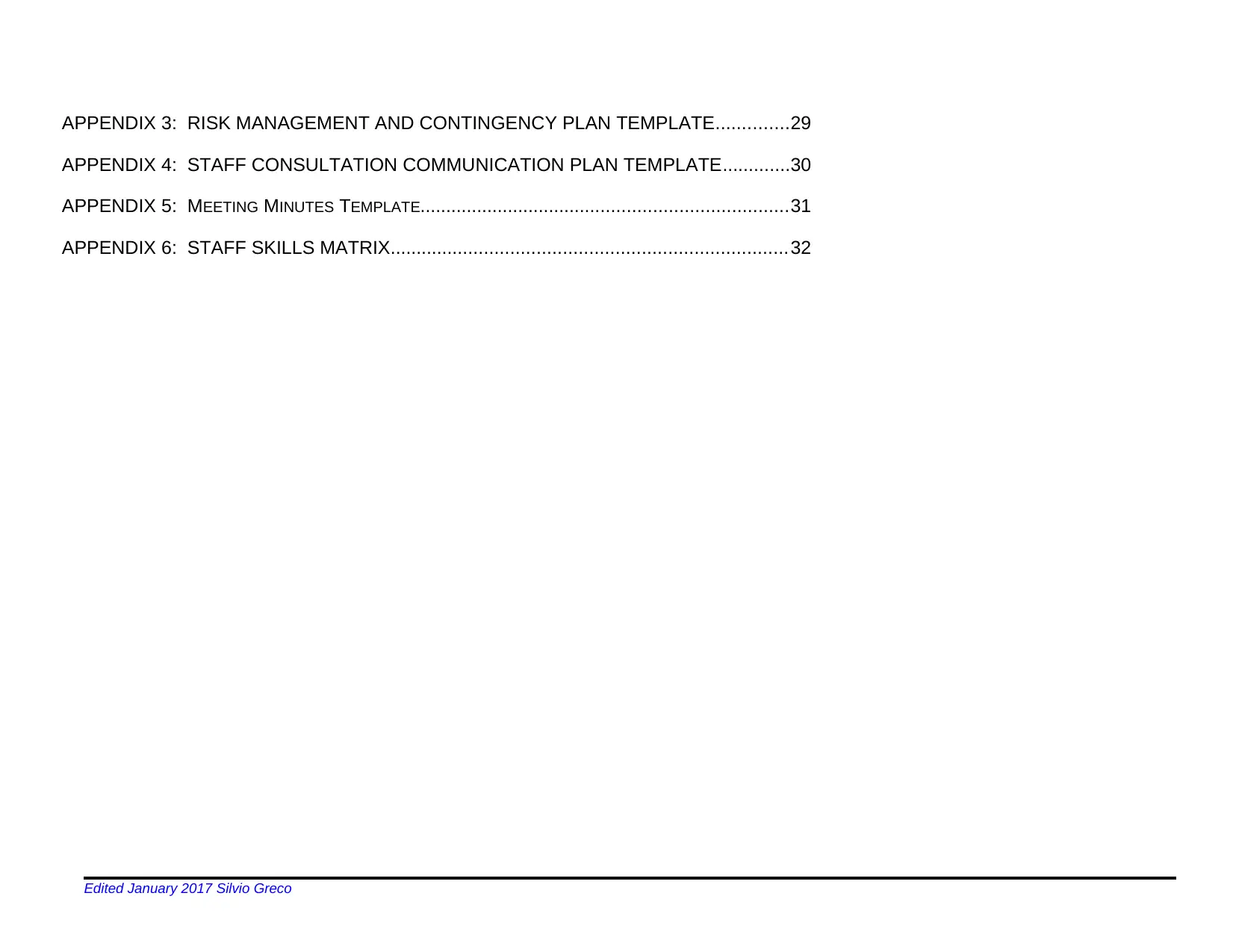
APPENDIX 3: RISK MANAGEMENT AND CONTINGENCY PLAN TEMPLATE..............29
APPENDIX 4: STAFF CONSULTATION COMMUNICATION PLAN TEMPLATE.............30
APPENDIX 5: MEETING MINUTES TEMPLATE.......................................................................31
APPENDIX 6: STAFF SKILLS MATRIX............................................................................32
Edited January 2017 Silvio Greco
APPENDIX 4: STAFF CONSULTATION COMMUNICATION PLAN TEMPLATE.............30
APPENDIX 5: MEETING MINUTES TEMPLATE.......................................................................31
APPENDIX 6: STAFF SKILLS MATRIX............................................................................32
Edited January 2017 Silvio Greco
⊘ This is a preview!⊘
Do you want full access?
Subscribe today to unlock all pages.

Trusted by 1+ million students worldwide
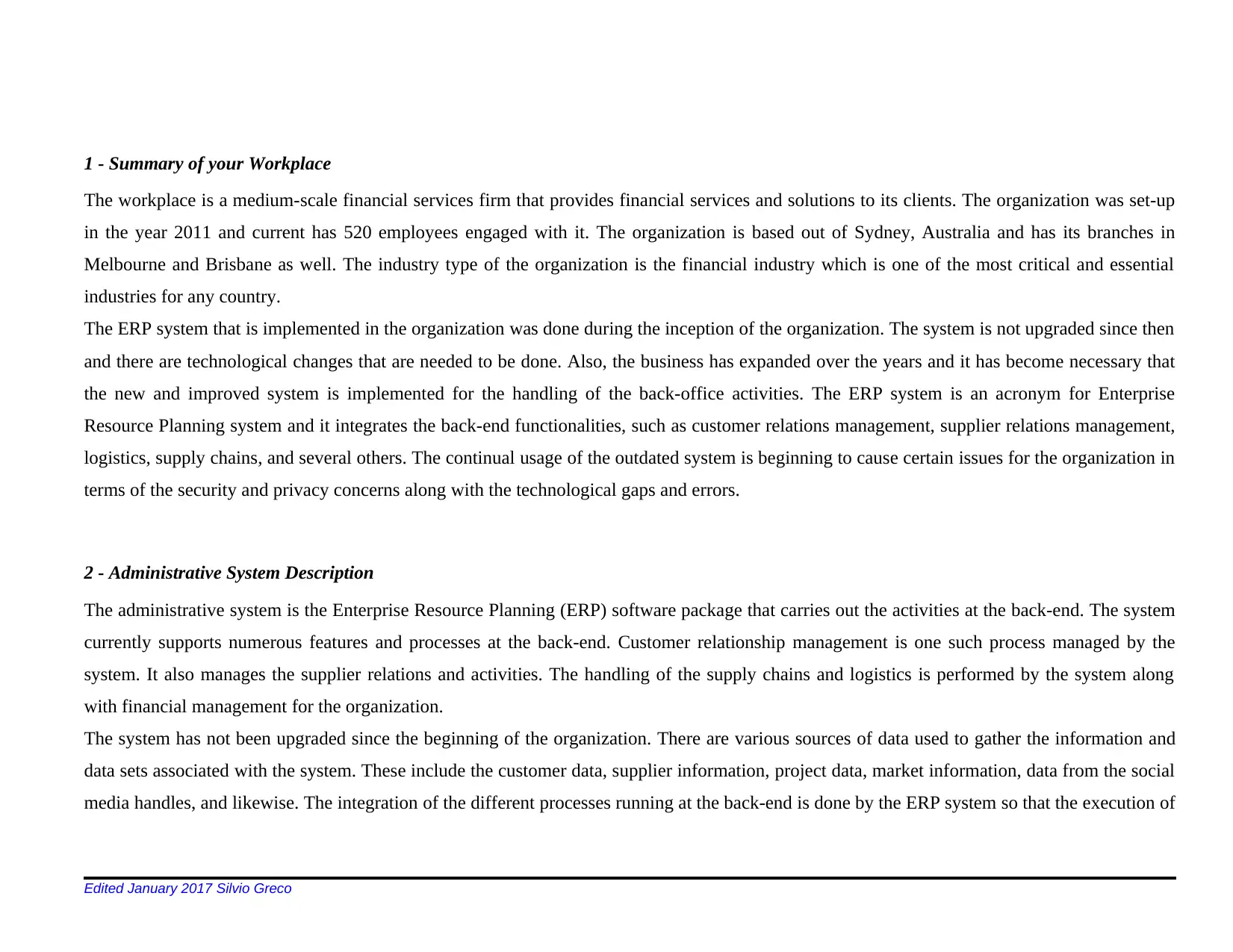
1 - Summary of your Workplace
The workplace is a medium-scale financial services firm that provides financial services and solutions to its clients. The organization was set-up
in the year 2011 and current has 520 employees engaged with it. The organization is based out of Sydney, Australia and has its branches in
Melbourne and Brisbane as well. The industry type of the organization is the financial industry which is one of the most critical and essential
industries for any country.
The ERP system that is implemented in the organization was done during the inception of the organization. The system is not upgraded since then
and there are technological changes that are needed to be done. Also, the business has expanded over the years and it has become necessary that
the new and improved system is implemented for the handling of the back-office activities. The ERP system is an acronym for Enterprise
Resource Planning system and it integrates the back-end functionalities, such as customer relations management, supplier relations management,
logistics, supply chains, and several others. The continual usage of the outdated system is beginning to cause certain issues for the organization in
terms of the security and privacy concerns along with the technological gaps and errors.
2 - Administrative System Description
The administrative system is the Enterprise Resource Planning (ERP) software package that carries out the activities at the back-end. The system
currently supports numerous features and processes at the back-end. Customer relationship management is one such process managed by the
system. It also manages the supplier relations and activities. The handling of the supply chains and logistics is performed by the system along
with financial management for the organization.
The system has not been upgraded since the beginning of the organization. There are various sources of data used to gather the information and
data sets associated with the system. These include the customer data, supplier information, project data, market information, data from the social
media handles, and likewise. The integration of the different processes running at the back-end is done by the ERP system so that the execution of
Edited January 2017 Silvio Greco
The workplace is a medium-scale financial services firm that provides financial services and solutions to its clients. The organization was set-up
in the year 2011 and current has 520 employees engaged with it. The organization is based out of Sydney, Australia and has its branches in
Melbourne and Brisbane as well. The industry type of the organization is the financial industry which is one of the most critical and essential
industries for any country.
The ERP system that is implemented in the organization was done during the inception of the organization. The system is not upgraded since then
and there are technological changes that are needed to be done. Also, the business has expanded over the years and it has become necessary that
the new and improved system is implemented for the handling of the back-office activities. The ERP system is an acronym for Enterprise
Resource Planning system and it integrates the back-end functionalities, such as customer relations management, supplier relations management,
logistics, supply chains, and several others. The continual usage of the outdated system is beginning to cause certain issues for the organization in
terms of the security and privacy concerns along with the technological gaps and errors.
2 - Administrative System Description
The administrative system is the Enterprise Resource Planning (ERP) software package that carries out the activities at the back-end. The system
currently supports numerous features and processes at the back-end. Customer relationship management is one such process managed by the
system. It also manages the supplier relations and activities. The handling of the supply chains and logistics is performed by the system along
with financial management for the organization.
The system has not been upgraded since the beginning of the organization. There are various sources of data used to gather the information and
data sets associated with the system. These include the customer data, supplier information, project data, market information, data from the social
media handles, and likewise. The integration of the different processes running at the back-end is done by the ERP system so that the execution of
Edited January 2017 Silvio Greco
Paraphrase This Document
Need a fresh take? Get an instant paraphrase of this document with our AI Paraphraser
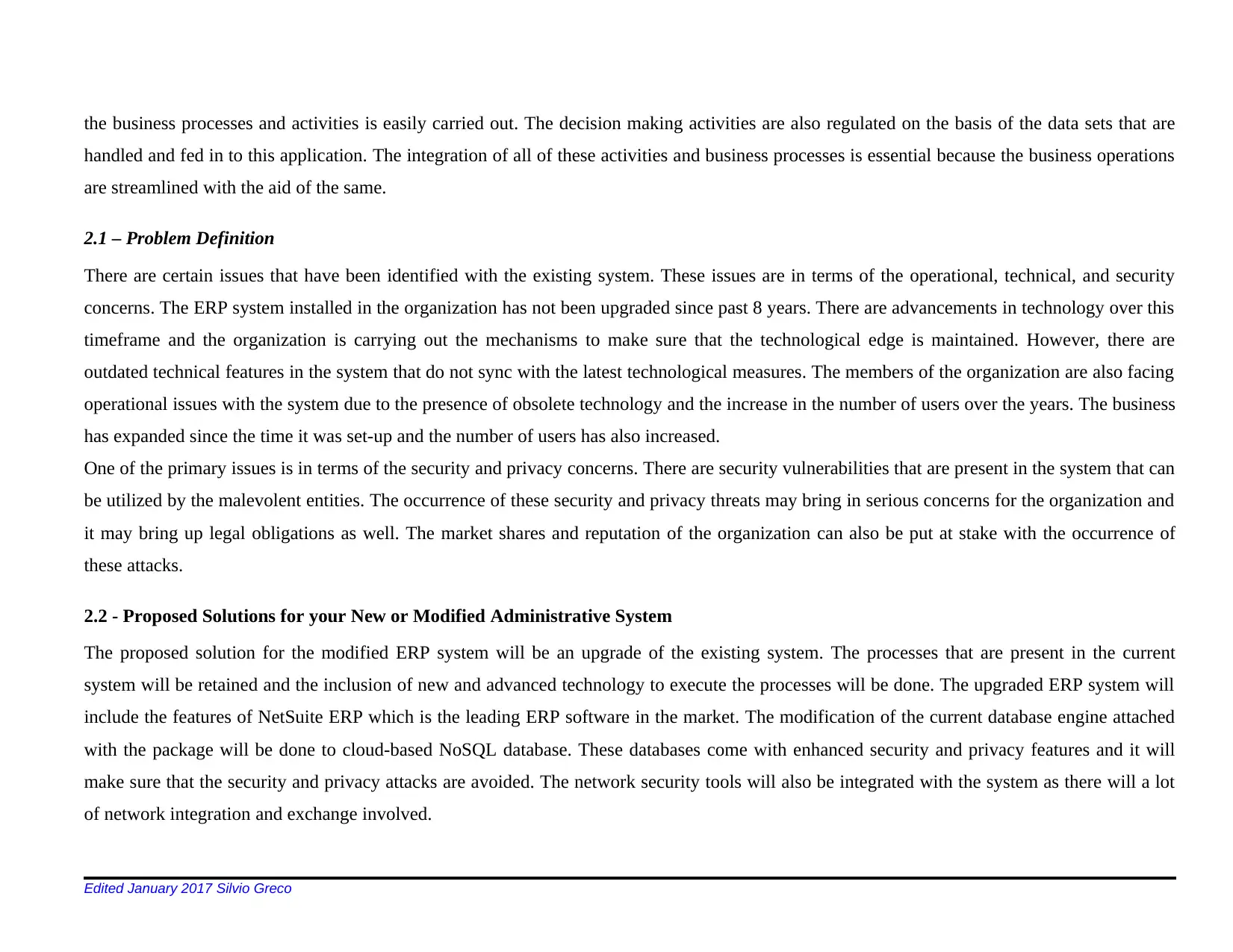
the business processes and activities is easily carried out. The decision making activities are also regulated on the basis of the data sets that are
handled and fed in to this application. The integration of all of these activities and business processes is essential because the business operations
are streamlined with the aid of the same.
2.1 – Problem Definition
There are certain issues that have been identified with the existing system. These issues are in terms of the operational, technical, and security
concerns. The ERP system installed in the organization has not been upgraded since past 8 years. There are advancements in technology over this
timeframe and the organization is carrying out the mechanisms to make sure that the technological edge is maintained. However, there are
outdated technical features in the system that do not sync with the latest technological measures. The members of the organization are also facing
operational issues with the system due to the presence of obsolete technology and the increase in the number of users over the years. The business
has expanded since the time it was set-up and the number of users has also increased.
One of the primary issues is in terms of the security and privacy concerns. There are security vulnerabilities that are present in the system that can
be utilized by the malevolent entities. The occurrence of these security and privacy threats may bring in serious concerns for the organization and
it may bring up legal obligations as well. The market shares and reputation of the organization can also be put at stake with the occurrence of
these attacks.
2.2 - Proposed Solutions for your New or Modified Administrative System
The proposed solution for the modified ERP system will be an upgrade of the existing system. The processes that are present in the current
system will be retained and the inclusion of new and advanced technology to execute the processes will be done. The upgraded ERP system will
include the features of NetSuite ERP which is the leading ERP software in the market. The modification of the current database engine attached
with the package will be done to cloud-based NoSQL database. These databases come with enhanced security and privacy features and it will
make sure that the security and privacy attacks are avoided. The network security tools will also be integrated with the system as there will a lot
of network integration and exchange involved.
Edited January 2017 Silvio Greco
handled and fed in to this application. The integration of all of these activities and business processes is essential because the business operations
are streamlined with the aid of the same.
2.1 – Problem Definition
There are certain issues that have been identified with the existing system. These issues are in terms of the operational, technical, and security
concerns. The ERP system installed in the organization has not been upgraded since past 8 years. There are advancements in technology over this
timeframe and the organization is carrying out the mechanisms to make sure that the technological edge is maintained. However, there are
outdated technical features in the system that do not sync with the latest technological measures. The members of the organization are also facing
operational issues with the system due to the presence of obsolete technology and the increase in the number of users over the years. The business
has expanded since the time it was set-up and the number of users has also increased.
One of the primary issues is in terms of the security and privacy concerns. There are security vulnerabilities that are present in the system that can
be utilized by the malevolent entities. The occurrence of these security and privacy threats may bring in serious concerns for the organization and
it may bring up legal obligations as well. The market shares and reputation of the organization can also be put at stake with the occurrence of
these attacks.
2.2 - Proposed Solutions for your New or Modified Administrative System
The proposed solution for the modified ERP system will be an upgrade of the existing system. The processes that are present in the current
system will be retained and the inclusion of new and advanced technology to execute the processes will be done. The upgraded ERP system will
include the features of NetSuite ERP which is the leading ERP software in the market. The modification of the current database engine attached
with the package will be done to cloud-based NoSQL database. These databases come with enhanced security and privacy features and it will
make sure that the security and privacy attacks are avoided. The network security tools will also be integrated with the system as there will a lot
of network integration and exchange involved.
Edited January 2017 Silvio Greco
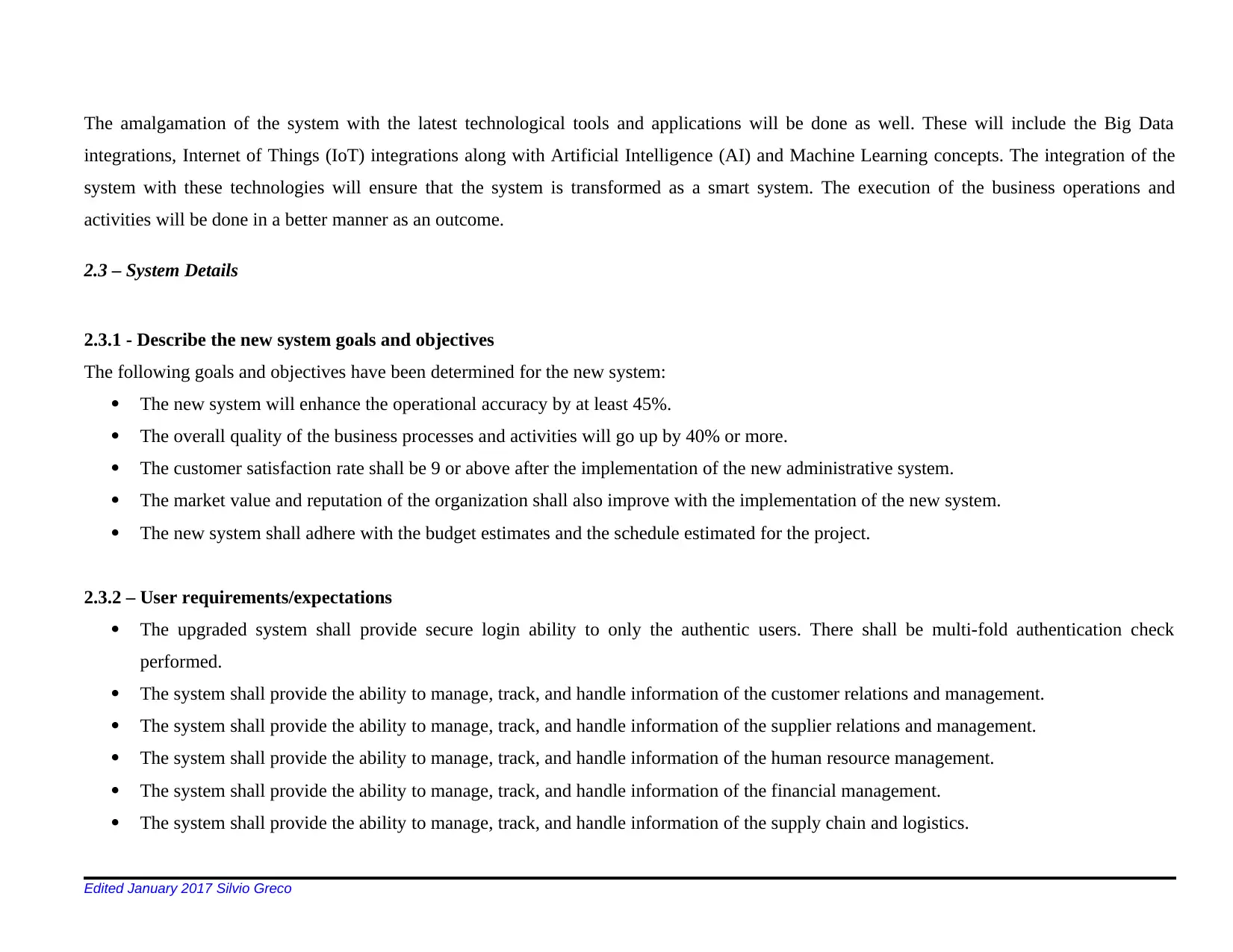
The amalgamation of the system with the latest technological tools and applications will be done as well. These will include the Big Data
integrations, Internet of Things (IoT) integrations along with Artificial Intelligence (AI) and Machine Learning concepts. The integration of the
system with these technologies will ensure that the system is transformed as a smart system. The execution of the business operations and
activities will be done in a better manner as an outcome.
2.3 – System Details
2.3.1 - Describe the new system goals and objectives
The following goals and objectives have been determined for the new system:
The new system will enhance the operational accuracy by at least 45%.
The overall quality of the business processes and activities will go up by 40% or more.
The customer satisfaction rate shall be 9 or above after the implementation of the new administrative system.
The market value and reputation of the organization shall also improve with the implementation of the new system.
The new system shall adhere with the budget estimates and the schedule estimated for the project.
2.3.2 – User requirements/expectations
The upgraded system shall provide secure login ability to only the authentic users. There shall be multi-fold authentication check
performed.
The system shall provide the ability to manage, track, and handle information of the customer relations and management.
The system shall provide the ability to manage, track, and handle information of the supplier relations and management.
The system shall provide the ability to manage, track, and handle information of the human resource management.
The system shall provide the ability to manage, track, and handle information of the financial management.
The system shall provide the ability to manage, track, and handle information of the supply chain and logistics.
Edited January 2017 Silvio Greco
integrations, Internet of Things (IoT) integrations along with Artificial Intelligence (AI) and Machine Learning concepts. The integration of the
system with these technologies will ensure that the system is transformed as a smart system. The execution of the business operations and
activities will be done in a better manner as an outcome.
2.3 – System Details
2.3.1 - Describe the new system goals and objectives
The following goals and objectives have been determined for the new system:
The new system will enhance the operational accuracy by at least 45%.
The overall quality of the business processes and activities will go up by 40% or more.
The customer satisfaction rate shall be 9 or above after the implementation of the new administrative system.
The market value and reputation of the organization shall also improve with the implementation of the new system.
The new system shall adhere with the budget estimates and the schedule estimated for the project.
2.3.2 – User requirements/expectations
The upgraded system shall provide secure login ability to only the authentic users. There shall be multi-fold authentication check
performed.
The system shall provide the ability to manage, track, and handle information of the customer relations and management.
The system shall provide the ability to manage, track, and handle information of the supplier relations and management.
The system shall provide the ability to manage, track, and handle information of the human resource management.
The system shall provide the ability to manage, track, and handle information of the financial management.
The system shall provide the ability to manage, track, and handle information of the supply chain and logistics.
Edited January 2017 Silvio Greco
⊘ This is a preview!⊘
Do you want full access?
Subscribe today to unlock all pages.

Trusted by 1+ million students worldwide
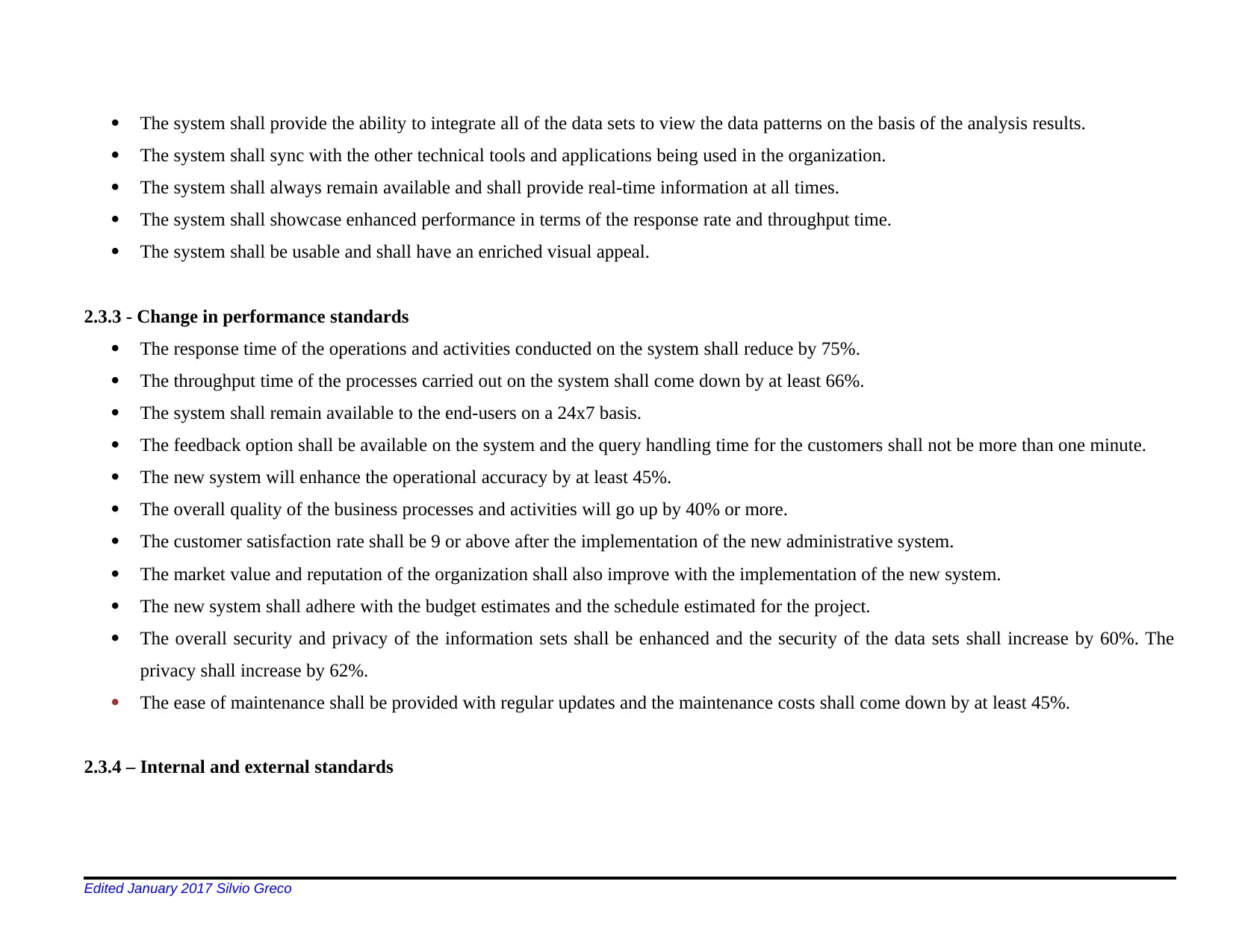
The system shall provide the ability to integrate all of the data sets to view the data patterns on the basis of the analysis results.
The system shall sync with the other technical tools and applications being used in the organization.
The system shall always remain available and shall provide real-time information at all times.
The system shall showcase enhanced performance in terms of the response rate and throughput time.
The system shall be usable and shall have an enriched visual appeal.
2.3.3 - Change in performance standards
The response time of the operations and activities conducted on the system shall reduce by 75%.
The throughput time of the processes carried out on the system shall come down by at least 66%.
The system shall remain available to the end-users on a 24x7 basis.
The feedback option shall be available on the system and the query handling time for the customers shall not be more than one minute.
The new system will enhance the operational accuracy by at least 45%.
The overall quality of the business processes and activities will go up by 40% or more.
The customer satisfaction rate shall be 9 or above after the implementation of the new administrative system.
The market value and reputation of the organization shall also improve with the implementation of the new system.
The new system shall adhere with the budget estimates and the schedule estimated for the project.
The overall security and privacy of the information sets shall be enhanced and the security of the data sets shall increase by 60%. The
privacy shall increase by 62%.
The ease of maintenance shall be provided with regular updates and the maintenance costs shall come down by at least 45%.
2.3.4 – Internal and external standards
Edited January 2017 Silvio Greco
The system shall sync with the other technical tools and applications being used in the organization.
The system shall always remain available and shall provide real-time information at all times.
The system shall showcase enhanced performance in terms of the response rate and throughput time.
The system shall be usable and shall have an enriched visual appeal.
2.3.3 - Change in performance standards
The response time of the operations and activities conducted on the system shall reduce by 75%.
The throughput time of the processes carried out on the system shall come down by at least 66%.
The system shall remain available to the end-users on a 24x7 basis.
The feedback option shall be available on the system and the query handling time for the customers shall not be more than one minute.
The new system will enhance the operational accuracy by at least 45%.
The overall quality of the business processes and activities will go up by 40% or more.
The customer satisfaction rate shall be 9 or above after the implementation of the new administrative system.
The market value and reputation of the organization shall also improve with the implementation of the new system.
The new system shall adhere with the budget estimates and the schedule estimated for the project.
The overall security and privacy of the information sets shall be enhanced and the security of the data sets shall increase by 60%. The
privacy shall increase by 62%.
The ease of maintenance shall be provided with regular updates and the maintenance costs shall come down by at least 45%.
2.3.4 – Internal and external standards
Edited January 2017 Silvio Greco
Paraphrase This Document
Need a fresh take? Get an instant paraphrase of this document with our AI Paraphraser
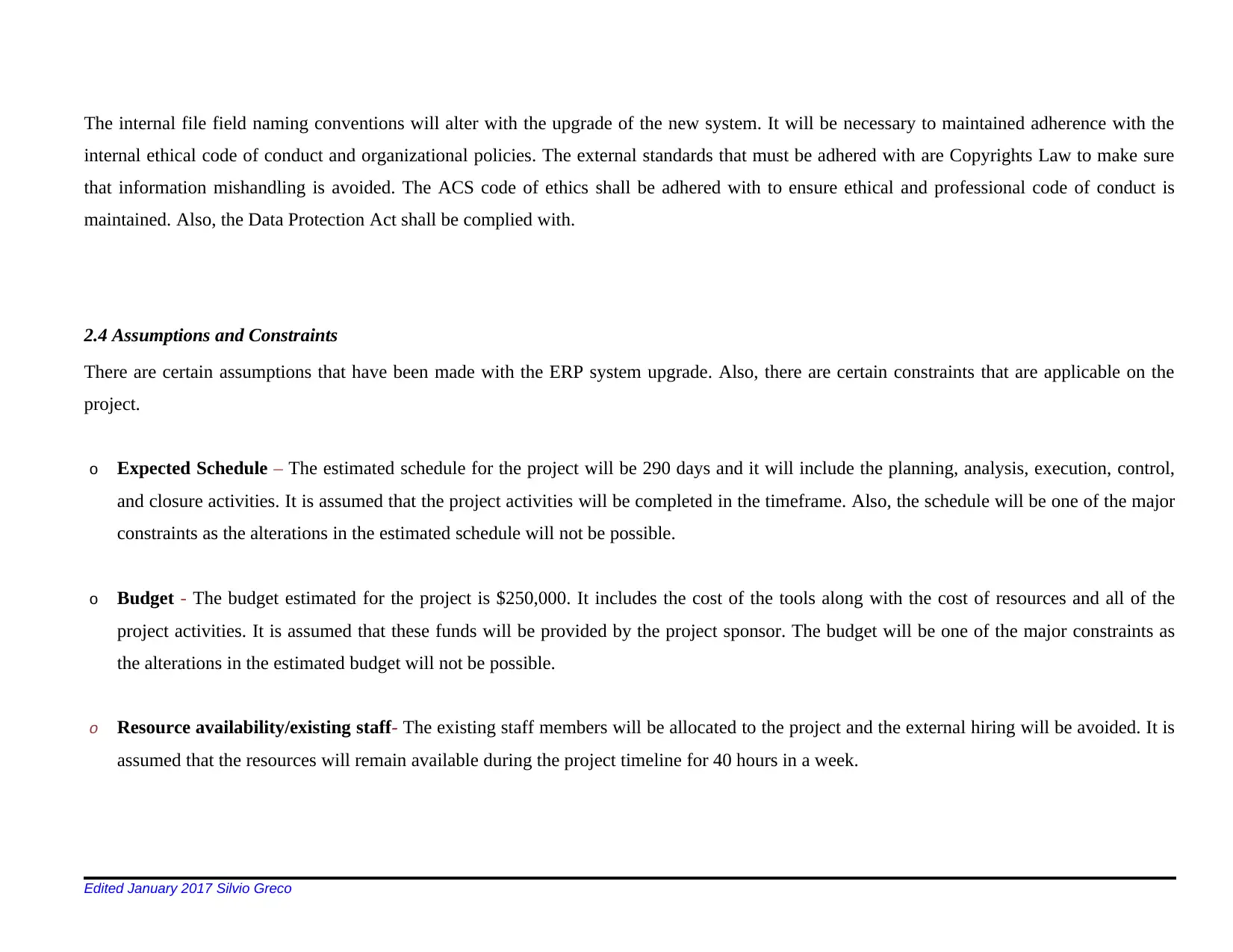
The internal file field naming conventions will alter with the upgrade of the new system. It will be necessary to maintained adherence with the
internal ethical code of conduct and organizational policies. The external standards that must be adhered with are Copyrights Law to make sure
that information mishandling is avoided. The ACS code of ethics shall be adhered with to ensure ethical and professional code of conduct is
maintained. Also, the Data Protection Act shall be complied with.
2.4 Assumptions and Constraints
There are certain assumptions that have been made with the ERP system upgrade. Also, there are certain constraints that are applicable on the
project.
o Expected Schedule – The estimated schedule for the project will be 290 days and it will include the planning, analysis, execution, control,
and closure activities. It is assumed that the project activities will be completed in the timeframe. Also, the schedule will be one of the major
constraints as the alterations in the estimated schedule will not be possible.
o Budget - The budget estimated for the project is $250,000. It includes the cost of the tools along with the cost of resources and all of the
project activities. It is assumed that these funds will be provided by the project sponsor. The budget will be one of the major constraints as
the alterations in the estimated budget will not be possible.
o Resource availability/existing staff- The existing staff members will be allocated to the project and the external hiring will be avoided. It is
assumed that the resources will remain available during the project timeline for 40 hours in a week.
Edited January 2017 Silvio Greco
internal ethical code of conduct and organizational policies. The external standards that must be adhered with are Copyrights Law to make sure
that information mishandling is avoided. The ACS code of ethics shall be adhered with to ensure ethical and professional code of conduct is
maintained. Also, the Data Protection Act shall be complied with.
2.4 Assumptions and Constraints
There are certain assumptions that have been made with the ERP system upgrade. Also, there are certain constraints that are applicable on the
project.
o Expected Schedule – The estimated schedule for the project will be 290 days and it will include the planning, analysis, execution, control,
and closure activities. It is assumed that the project activities will be completed in the timeframe. Also, the schedule will be one of the major
constraints as the alterations in the estimated schedule will not be possible.
o Budget - The budget estimated for the project is $250,000. It includes the cost of the tools along with the cost of resources and all of the
project activities. It is assumed that these funds will be provided by the project sponsor. The budget will be one of the major constraints as
the alterations in the estimated budget will not be possible.
o Resource availability/existing staff- The existing staff members will be allocated to the project and the external hiring will be avoided. It is
assumed that the resources will remain available during the project timeline for 40 hours in a week.
Edited January 2017 Silvio Greco
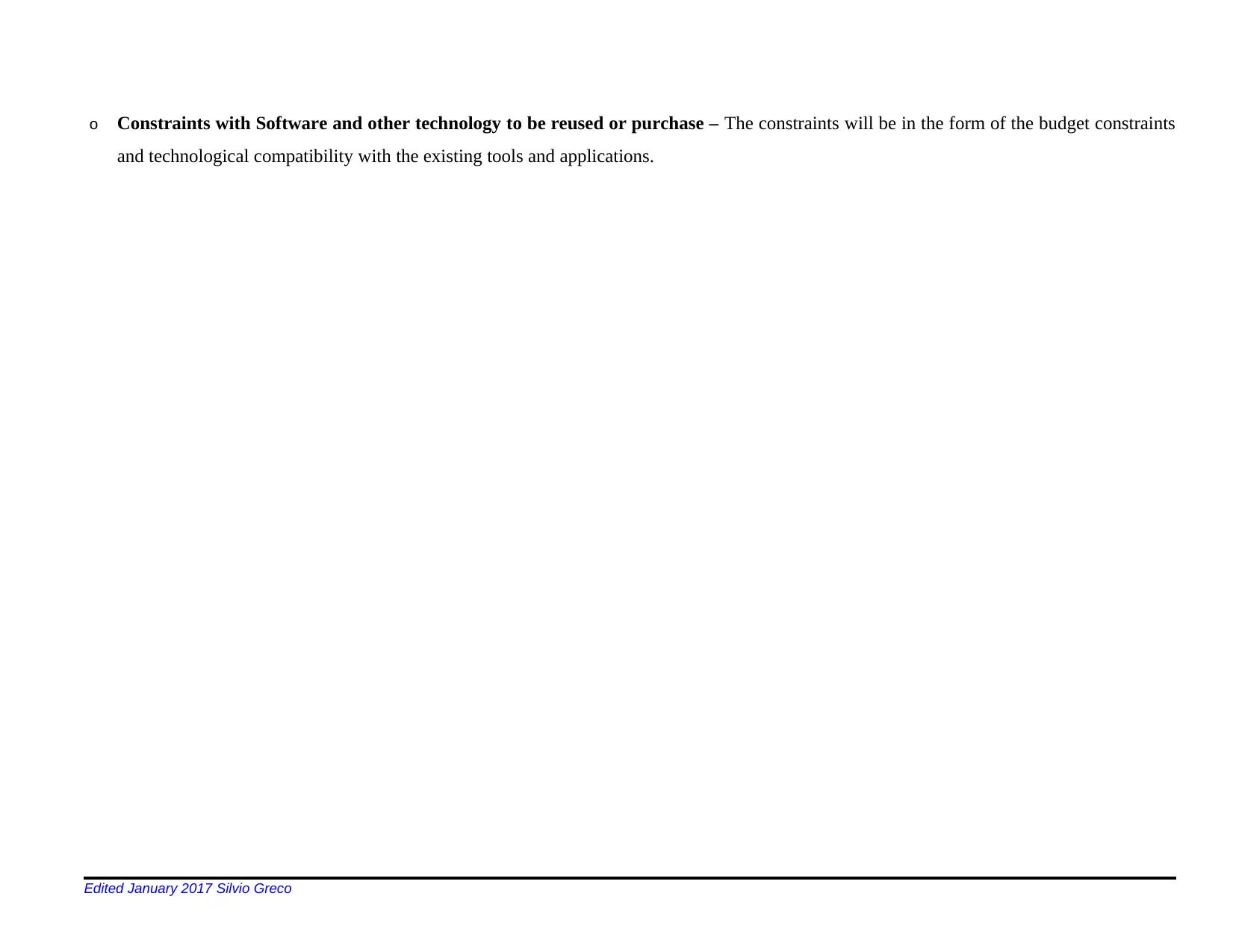
o Constraints with Software and other technology to be reused or purchase – The constraints will be in the form of the budget constraints
and technological compatibility with the existing tools and applications.
Edited January 2017 Silvio Greco
and technological compatibility with the existing tools and applications.
Edited January 2017 Silvio Greco
⊘ This is a preview!⊘
Do you want full access?
Subscribe today to unlock all pages.

Trusted by 1+ million students worldwide

2.5 New Policies and Procedures Required
The internal file field naming conventions will alter with the upgrade of the new system. It will be necessary to maintained adherence with the
internal ethical code of conduct and organizational policies. The external standards that must be adhered with are Copyrights Law to make sure
that information mishandling is avoided. The ACS code of ethics shall be adhered with to ensure ethical and professional code of conduct is
maintained. Also, the Data Protection Act shall be complied with.
3.0 Resources, Quotations and Supplier/Developer Needs/Associated Costs
3.1 The adherence to the current organizational contracting and tendering policies and procedures will be maintained using the review and audit
processes. The Procurement team and manager will be involved in ensure that the adherence to the existing policies, regulations, and standards is
maintained.
There will be Procurement Management Plan that will be developed by the Procurement Manager in the initial phase of the project. The details of
the same will be included in the project plan as well. The review cycles and audit processes will be conducted throughout the project and
especially during the procurement phase. The results of these reports and processes will be used to make sure that the compliance levels are
always maintained.
There are financial constraints that are applicable on the project. The adherence to these financial constraints will be made using earned value
analysis (EVA) as the technique. The cost variance levels determined in this technique shall be either zero or positive during the entire lifecycle
of the project. The Procurement Manager along with the Project Manager will be involved in the process to make sure that the adherence levels
are maintained at all times and the tolerance levels are never exceeded.
3.2 – The communication tools and methods that will be used to share information with the stakeholders will be emails, face to face meetings,
reports, and tele-conferencing mediums.
Edited January 2017 Silvio Greco
The internal file field naming conventions will alter with the upgrade of the new system. It will be necessary to maintained adherence with the
internal ethical code of conduct and organizational policies. The external standards that must be adhered with are Copyrights Law to make sure
that information mishandling is avoided. The ACS code of ethics shall be adhered with to ensure ethical and professional code of conduct is
maintained. Also, the Data Protection Act shall be complied with.
3.0 Resources, Quotations and Supplier/Developer Needs/Associated Costs
3.1 The adherence to the current organizational contracting and tendering policies and procedures will be maintained using the review and audit
processes. The Procurement team and manager will be involved in ensure that the adherence to the existing policies, regulations, and standards is
maintained.
There will be Procurement Management Plan that will be developed by the Procurement Manager in the initial phase of the project. The details of
the same will be included in the project plan as well. The review cycles and audit processes will be conducted throughout the project and
especially during the procurement phase. The results of these reports and processes will be used to make sure that the compliance levels are
always maintained.
There are financial constraints that are applicable on the project. The adherence to these financial constraints will be made using earned value
analysis (EVA) as the technique. The cost variance levels determined in this technique shall be either zero or positive during the entire lifecycle
of the project. The Procurement Manager along with the Project Manager will be involved in the process to make sure that the adherence levels
are maintained at all times and the tolerance levels are never exceeded.
3.2 – The communication tools and methods that will be used to share information with the stakeholders will be emails, face to face meetings,
reports, and tele-conferencing mediums.
Edited January 2017 Silvio Greco
Paraphrase This Document
Need a fresh take? Get an instant paraphrase of this document with our AI Paraphraser
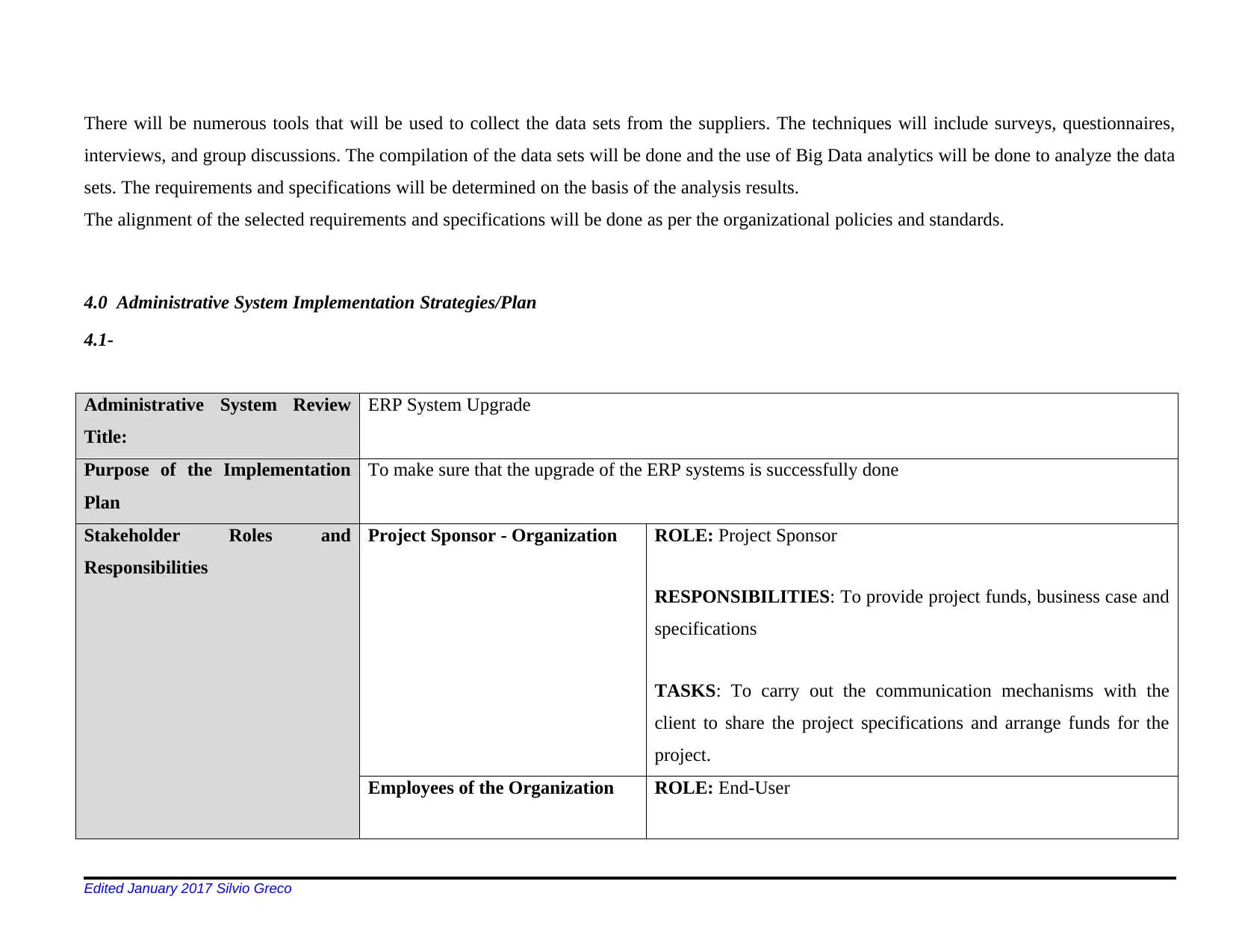
There will be numerous tools that will be used to collect the data sets from the suppliers. The techniques will include surveys, questionnaires,
interviews, and group discussions. The compilation of the data sets will be done and the use of Big Data analytics will be done to analyze the data
sets. The requirements and specifications will be determined on the basis of the analysis results.
The alignment of the selected requirements and specifications will be done as per the organizational policies and standards.
4.0 Administrative System Implementation Strategies/Plan
4.1-
Administrative System Review
Title:
ERP System Upgrade
Purpose of the Implementation
Plan
To make sure that the upgrade of the ERP systems is successfully done
Stakeholder Roles and
Responsibilities
Project Sponsor - Organization ROLE: Project Sponsor
RESPONSIBILITIES: To provide project funds, business case and
specifications
TASKS: To carry out the communication mechanisms with the
client to share the project specifications and arrange funds for the
project.
Employees of the Organization ROLE: End-User
Edited January 2017 Silvio Greco
interviews, and group discussions. The compilation of the data sets will be done and the use of Big Data analytics will be done to analyze the data
sets. The requirements and specifications will be determined on the basis of the analysis results.
The alignment of the selected requirements and specifications will be done as per the organizational policies and standards.
4.0 Administrative System Implementation Strategies/Plan
4.1-
Administrative System Review
Title:
ERP System Upgrade
Purpose of the Implementation
Plan
To make sure that the upgrade of the ERP systems is successfully done
Stakeholder Roles and
Responsibilities
Project Sponsor - Organization ROLE: Project Sponsor
RESPONSIBILITIES: To provide project funds, business case and
specifications
TASKS: To carry out the communication mechanisms with the
client to share the project specifications and arrange funds for the
project.
Employees of the Organization ROLE: End-User
Edited January 2017 Silvio Greco
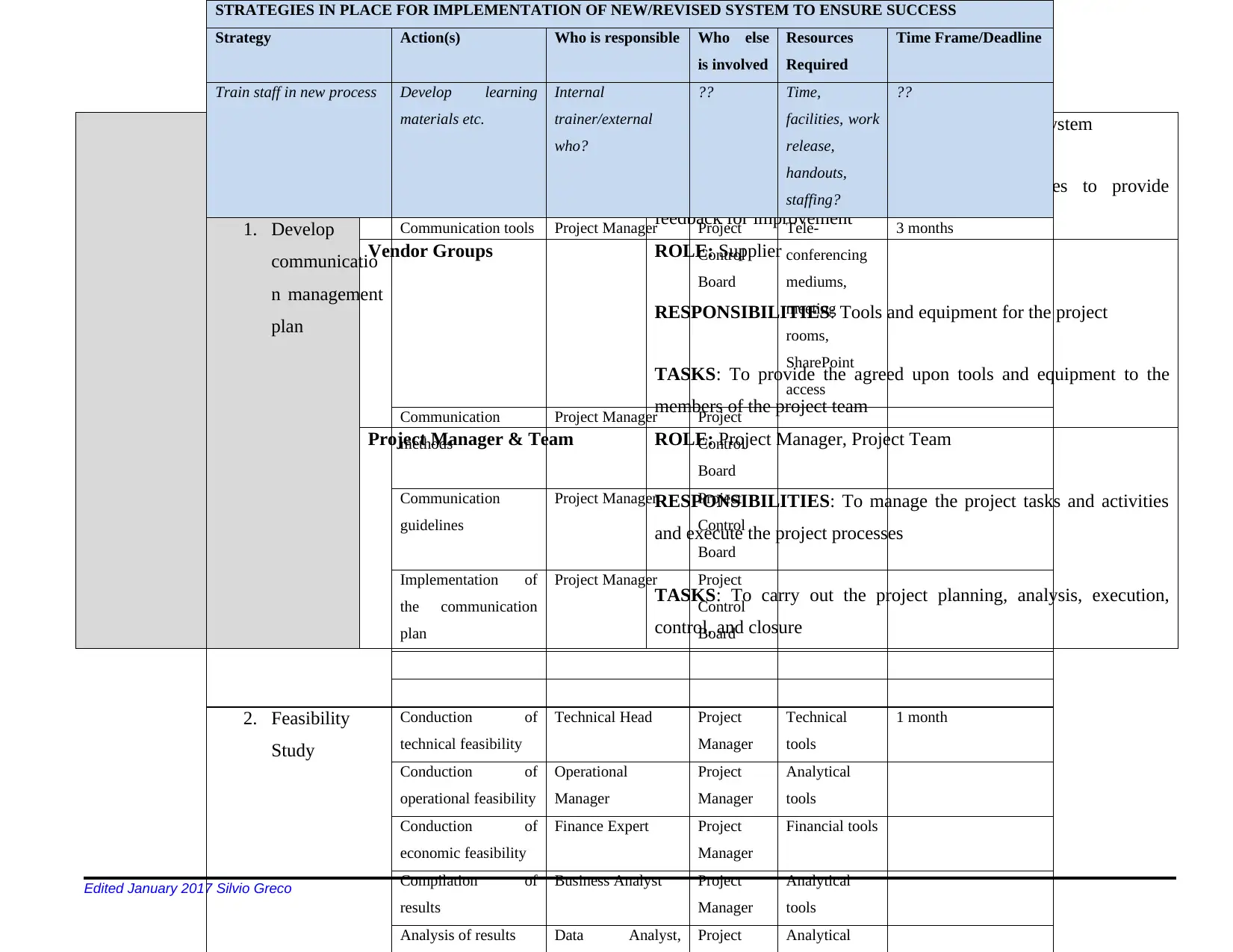
RESPONSIBILITIES: Feedback on the upgraded system
TASKS: Execution of the system functionalities to provide
feedback for improvement
Vendor Groups ROLE: Supplier
RESPONSIBILITIES: Tools and equipment for the project
TASKS: To provide the agreed upon tools and equipment to the
members of the project team
Project Manager & Team ROLE: Project Manager, Project Team
RESPONSIBILITIES: To manage the project tasks and activities
and execute the project processes
TASKS: To carry out the project planning, analysis, execution,
control, and closure
Edited January 2017 Silvio Greco
STRATEGIES IN PLACE FOR IMPLEMENTATION OF NEW/REVISED SYSTEM TO ENSURE SUCCESS
Strategy Action(s) Who is responsible Who else
is involved
Resources
Required
Time Frame/Deadline
Train staff in new process Develop learning
materials etc.
Internal
trainer/external
who?
?? Time,
facilities, work
release,
handouts,
staffing?
??
1. Develop
communicatio
n management
plan
Communication tools Project Manager Project
Control
Board
Tele-
conferencing
mediums,
meeting
rooms,
SharePoint
access
3 months
Communication
methods
Project Manager Project
Control
Board
Communication
guidelines
Project Manager Project
Control
Board
Implementation of
the communication
plan
Project Manager Project
Control
Board
2. Feasibility
Study
Conduction of
technical feasibility
Technical Head Project
Manager
Technical
tools
1 month
Conduction of
operational feasibility
Operational
Manager
Project
Manager
Analytical
tools
Conduction of
economic feasibility
Finance Expert Project
Manager
Financial tools
Compilation of
results
Business Analyst Project
Manager
Analytical
tools
Analysis of results Data Analyst, Project Analytical
TASKS: Execution of the system functionalities to provide
feedback for improvement
Vendor Groups ROLE: Supplier
RESPONSIBILITIES: Tools and equipment for the project
TASKS: To provide the agreed upon tools and equipment to the
members of the project team
Project Manager & Team ROLE: Project Manager, Project Team
RESPONSIBILITIES: To manage the project tasks and activities
and execute the project processes
TASKS: To carry out the project planning, analysis, execution,
control, and closure
Edited January 2017 Silvio Greco
STRATEGIES IN PLACE FOR IMPLEMENTATION OF NEW/REVISED SYSTEM TO ENSURE SUCCESS
Strategy Action(s) Who is responsible Who else
is involved
Resources
Required
Time Frame/Deadline
Train staff in new process Develop learning
materials etc.
Internal
trainer/external
who?
?? Time,
facilities, work
release,
handouts,
staffing?
??
1. Develop
communicatio
n management
plan
Communication tools Project Manager Project
Control
Board
Tele-
conferencing
mediums,
meeting
rooms,
SharePoint
access
3 months
Communication
methods
Project Manager Project
Control
Board
Communication
guidelines
Project Manager Project
Control
Board
Implementation of
the communication
plan
Project Manager Project
Control
Board
2. Feasibility
Study
Conduction of
technical feasibility
Technical Head Project
Manager
Technical
tools
1 month
Conduction of
operational feasibility
Operational
Manager
Project
Manager
Analytical
tools
Conduction of
economic feasibility
Finance Expert Project
Manager
Financial tools
Compilation of
results
Business Analyst Project
Manager
Analytical
tools
Analysis of results Data Analyst, Project Analytical
⊘ This is a preview!⊘
Do you want full access?
Subscribe today to unlock all pages.

Trusted by 1+ million students worldwide
1 out of 28
Related Documents
Your All-in-One AI-Powered Toolkit for Academic Success.
+13062052269
info@desklib.com
Available 24*7 on WhatsApp / Email
![[object Object]](/_next/static/media/star-bottom.7253800d.svg)
Unlock your academic potential
Copyright © 2020–2025 A2Z Services. All Rights Reserved. Developed and managed by ZUCOL.





